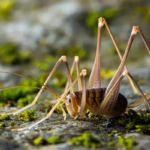Why Do Fireflies Glow And Other Illuminating Facts
Check out these "illuminating" facts about these fascinating insects.

Many backyards are already aglow with magical fireflies—or lightning bugs as many people call them. On warm evenings, there’s nothing better than sitting and watching them light up the night. Here are a few fascinating facts about fireflies you may not know.
10 Fascinating Facts About Fireflies
- It turns out that it’s not just the adult firefly that lights up. Among some species, the eggs glow, and the eggs of certain species will flash if you tap them gently. Most larva – often called glowworms – are also capable of producing light.
- They’re energy efficient. No man-made light source can claim to be entirely energy efficient, but a firefly’s glowing tail uses 100% of the energy it produces to emit light. By comparison, the average incandescent lightbulb releases 90% of its energy as heat and 10% as light, while fluorescent bulbs release 30% as heat and 70% as light.
- The flashing is more than just a pretty light show. Among the species of fireflies that produce a glow, each one has its own unique flash pattern, and they use the flashes to attract mates. Females wait in tall foliage, flashing to attract males. The males flash in response as they move closer to the females. The glow is also a handy way to repel predators. Since fireflies produce bitter chemicals as a response to predators, most insect-eating animals know that if it lights up, it tastes bad.
- It’s easy to identify fireflies by their flash patterns. Photinus pyralis is one of the more common types found in the United States, and this species always makes a J-shaped flash by lighting up as they fly in an arc. Photinus brimley flies in a straight line and produces one flash every three to eight seconds. Photinus consimilis makes a double flash every five seconds, and Photinus collustrans flashes three times in two to three seconds.
- Some fireflies are tricksters. While adults of most species eat pollen or smaller insects, some females of the Photuris genus prey on male lightning bugs of other species. They’ll lure the males in by mimicking their flash patterns. And, since female Photuris fireflies gravitate towards the flash patterns of different species, male Photuris fireflies mimic those species to attract the females.
- Not all fireflies make yellow or green light. Pyractomena lightning bugs, for instance, create orange light. In the southern United States, you may chance across Phausis reticulata, or the Blue Ghost lightning bug. Blue Ghosts don’t flash at all, instead, they produce a soft but steady blue glow. Others, particularly those that live in the western United States, don’t light up at all.
- Some fireflies can actually synchronize their flashes. In the United States, there is only one synchronous species – Photinus carolinus—and there are only a few spots to watch as they put on one of nature’s greatest light shows. You can catch a glimpse in the Allegheny National Forest in Pennsylvania or the Congaree National Park in South Carolina. The best place to watch, however, is the Great Smoky Mountains National Park in Tennessee. People flock to this park every May and June to watch as thousands of lightning bugs produce perfectly timed flashes.
- Lightning bugs glow because their tails contain just the right chemicals and enzymes (calcium, adenosine triphosphate, luciferin, and luciferase) to create a bioluminescent chemical reaction. These insects control the flashing by adding oxygen to start the chemical reaction within the light-producing organ in their tails.
- They help save lives. Researchers have discovered that the luciferase produced by fireflies is useful for anything from detecting blood clots to tracking the efficacy of cancer medications. In fact, scientists have learned how to make synthetic luciferase, which means that the medical industry no longer needs to harvest this bioluminescent chemical from them.
- They have surprisingly short life spans – only one season. They spend most of their adult lives searching for a mate. Once mated, the females lay their eggs and die shortly thereafter. New crops hatch the following spring and the cycle starts over!
Read: Are fireflies disappearing?
Watch this footage of the Tennessee Fireflies lighting up the sky in the Great Smoky Mountains:

Amber Kanuckel
Amber Kanuckel is a freelance writer from rural Ohio who loves all things outdoors. She specializes in home, garden, environmental, and green living topics.






This is the first year I have seen fireflies in my back yard and they flash orange! It’s nice to see them again! I’ve been here since 2003!
I spy a lighning bug 2021 interlachen fl. April 14th
I have enjoyed 31 summers of lighting bugs all thru an over 200 yr old oak in my front yard & pasture. Watching my kids & now grand kids catch & release them.
I have noticed that the fire flies have declined a bunch this year. It might because of all the rain and cool tempatures this spring. I really miss them.
I live in luray va. I have been watching the lighting bugs for the last few weeks, and I noticed that they come up from the ground, and go straight up in the trees and stay there all night, not very many flying around, but the trees are pretty, looks like Xmas lites, does anyone know why ,they mostly stay in the tree
Mating and laying eggs
I have seen synchronous firefly displays in northern Ohio.
I have seen fireflies (or as we Kansan’s call them lightning bugs) every evening for the last few weeks. Coincidentally it has been very humid here, a wet spring to say the least. So I was wondering, do fireflies become active as the rain moves through the area? Or is it just a coincidence? Either way I’ve been chasing them around for over 50 years and now I watch my grand kids as they experience the great lightning bug chase in the dark.
You look tasty x
All us normal people call them lightning bugs. Only geeks call them fireflies.
I enjoyed reading this article and I was excited to see the video of all the lightning bugs, as we called them. I still sometimes see lightning bugs but there doesn’t seem to be as many as there once was. So sad.
Hi Gary, we’re so glad you enjoyed it! Yes, we called them lightning bugs, too. We also ran another story in early spring about what causes them to “appear” and it’s all about the weather — this might answer the question about why you haven’t seen as many. Take a look: Are Fireflies Disappearing?
There really are flashing fireflies in the west but you have to know where to look. It has often been said that there are none west of Kansas or none west of the Rocky Mountains but I have seen 8 different locations within 30 minutes drive from my home in Utah. They are just being rediscovered here but older people I know who grew up on farms here used to catch them when they were children. One of those was catching them 80 years ago. I only learned about fireflies in Utah about 4 years ago when there was a local newscast about it. I have lived here since the 1960’s and was always told that there are no fireflies. Now I go out many nights during the summer to help discover new locations. The Utah Museum of Natural History website started a map that shows more than 100 reported locations all over the state. Do a Google search for Utah Firefly map. They are even in southern Utah in the desert near Moab and Lake Powell but always near water as expected. There are many reports in all of the other western states too but I haven’t seen them there myself yet. Another good map of fireflies in the U.S. is found by googling Museum of Science Firefly Watch.
My wife and I, here in SE Wisconsin, notice that every time a firefly glows it is rising — never flying level or descending. Can anyone tell us why?
Well start breeding fireflies to light up Tenney Mountain for night Skiing